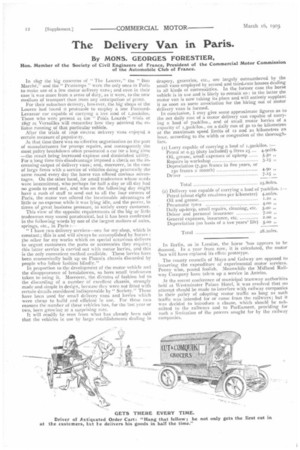The Delivery Van in Paris.
Page 12

If you've noticed an error in this article please click here to report it so we can fix it.
By MONS. GEORGES FORESTIER,
Member of the Society of Civil Engineers of France, President of the Commercial Motor Commission of the Automobile Club of France.
In 1897 the big concerns of " The Louvre," the " Bon Marche," and the" Printemps " were the only ones in Paris to make use of a few motor oelivery vans; and even in their case it was more from a sense of duty, as it were, to the new medium of transport rhan from any anticipation of proht. For their suburban delivery, however, the big shops of the Louvre had found it prohtaule to employ a line PanhardLevassor car capable of carrying a live toad of 1,200kilos. Those who were present at the " Folds Lourds " trials ot 1897 at Versailles will remember how they admired the reliable running of that particular vehicle.
After the trials of 1898 electric delivery vans enjoyed a certain measure of popularity.
Ai that time there was no effective organisation on the part of manufacturers for prompt repairs, and consequently the most paltry breakdown often prostrated a car for a long time —the result being increased expense and diminished utility. For a long time this disadvantage imposed a check on the increasing output of delivery vans ; and, moreover, in the case of large firms with a service of vehicles doing practically the same round every day the horse van offered obvious aovantages. On the other hand, for small tradesmen whose nceds were intermittent, who perhaps for half a day or all day had no goods to send out, and who on the following day might have a rush of stuff to send out to all the four corners of Paris, the motor van offered the inestimable advantages of little or no expense while it was lying idle, and the power, in times of great business pressure, to satisfy every customer. This view of the opposite requirements of the big or little tradesman may sound paradoxical, but it has been confirmed in the following words by one of the largest makers of axles. springs, etc., in Paris :— " I have two delivery services—one for my shop, which is constant; this is and will always be accomplished by horses : the other for my works which on special occasions delivers to urgent customers the parts or accessories they require; this latter service is carried out with motor lorries, and this is the only convenient method available. These lorries have been economically built up on Phcenix chassis discarded by people who follow fashion blindly."
In proportion to the development of the motor vehicle and the disappearance of breakdowns, so have small tradesmen taken to using it. Moreover, the dictates of fashion led to the discarding of a number of excellent chassis, strongly made and simple in design, because they were not fitted with certain details considered indispensable by " Society." These have been used for small delivery vans and lorries which were cheap to build and efficient in use. For these two reasons the number of these vehicles has, for the last year or two, been growingat a surprising rate.
It will readily be seen from what has already been said that the vehicles in use by large establishments dealing in drapery, groceries, etc., are largely outnumbered by the small vans employed by second and tnird-rate houses dealing in all kinds of commodities. In the former case the horse vehicle is in use and is likely to remain so : in the latter the motor van is now taking its place and will entirely supplant it as soon as some association for the hiring out of motor delivery vans is formed. In conclusion, I may give some approximate figures as to the net daily cost of a motor delivery van capable of carrying a load of 700kilos., and of small motor lorries of a capacity of 1,5ookilos., on a daily run of so to 6o kilometres at the maximum speed limits of 12 and 20 kilometres an hour, according to the width or congestion of the thoroughfare.
(t) Lorry capable of carrying a load of i,sookilos.
Petrol at 0.53 (duty included) 9 litres 25 4.9ofrs.
Oil, grease, small expenses of upkeep Repairs in workshop 3.23 „ Depreciation (7,500 francs in five years, or
250 francs a month) 4-90 o Driver 7-25
In Berlin, as in London, the horse 'bus appears to be doomed. In a year from now, it is calculated, the motor 'bus will have replaced its effete prototype.
The county councils of Mayo and Galway are opposed to incurring the expenditure of experimental motor services. Penny wise, pound foolish. Meanwhile the Midland Railway Company have taken up a service in .Antrim.
At the recent conference of municipal tramway authorities held at ‘Vestminster Palace Hotel, it was resolved that no attempt should be made to interfere with railway companies in their policy of adopting motor traffic so long as such traffic was intended for or came from the railways; but it was decided to introduce a clause, which should be submitted to the railways and to Parliament, providing for such a limitation of the powers sought for by the railway companies,
























